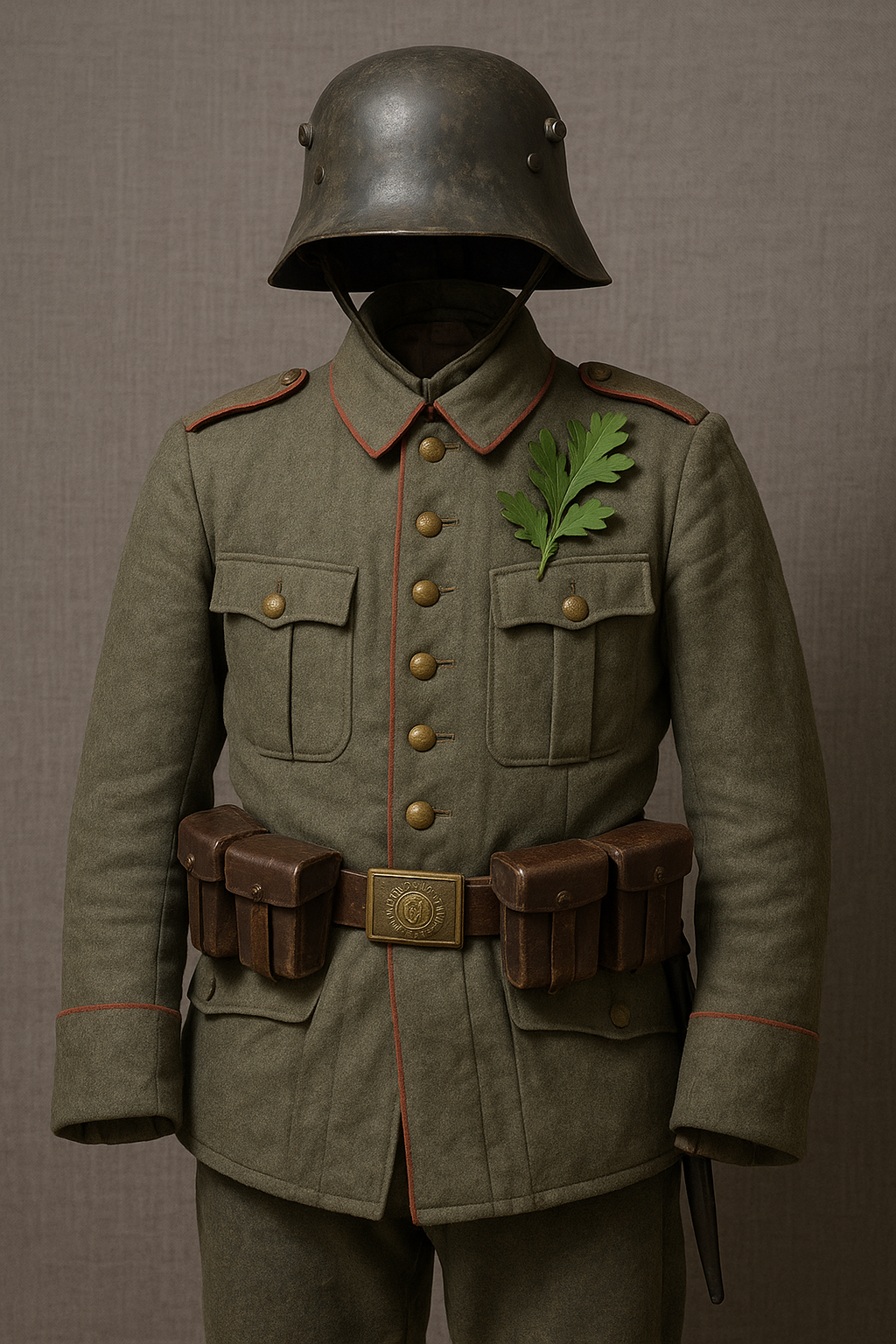
Did the German Army Reuse Uniforms in WW1? Colors, History & DIY Tips for Enthusiasts
Published on Sep 20, 2025
Did the German Army Reuse Uniforms in WW1? A Deep Dive into Color, Reuse & DIY Uniform Building
"By the end of WW1, Germany had mobilized over 13 million soldiers. Ever wonder how they kept all of them clothed?"
If you're a fan of military history, WW1 reenactments, or love diving deep into historical military gear, you've probably asked yourself: Did the German Army reuse uniforms in WW1? Alongside that, you might also be wondering what color German uniforms were in WW1, and why some had mysterious green leaves or insignias on them.
In this comprehensive guide, we’ll not only answer these questions but help you avoid common pitfalls in understanding and recreating WW1 German uniforms. Whether you're researching for a book, preparing for a reenactment, or planning to make your own uniform replica, this article is for you.
✅ What Color Were German Uniforms in WW1?
Feldgrau: The Signature Shade of WW1 German Uniforms
The early German Army entered WW1 in 1914 wearing Feldgrau (field gray), a muted gray-green shade that would become iconic.
🎯 Why Feldgrau?
- Camouflage: The previous bright uniforms (e.g., Prussian blue) stood out too much.
- Standardization: Feldgrau helped unify the German forces visually.
- Availability: Dyes for Feldgrau were easier to produce at scale during wartime shortages.
Fun Fact: Early Feldgrau had a more greenish tint. By 1915–1916, wartime dye shortages made the fabric appear browner or even bluish-gray.
🟩 Related Keyword Connection:
The “green leaves” you may see on German uniforms from WW1 often refer to oak leaf insignia, used to denote certain regiments or ranks, and occasionally as camo during forest campaigns.
🧥 Did the German Army Reuse Uniforms in WW1?
Yes—and Here's How It Affected Soldiers & Uniform Quality
The German Army, like many others during WW1, faced massive supply chain issues.
💡 Reuse Was Strategic and Necessary:
- Reissued After Repair: Uniforms were repaired and redistributed to new soldiers.
- Passed Down: Veterans' uniforms were often handed down to recruits.
- Dead Soldiers' Gear: In desperate times, uniforms from fallen soldiers were cleaned, patched, and reused—especially post-1916.
📌 Common Reuse Practices:
- Removing insignia and buttons before reuse.
- Darning and reweaving holes from shrapnel or trench wear.
- Modifying older uniforms to fit new regulations or designs.
Important Note: This reuse led to wide variation in how "standard" a uniform looked from one soldier to another—especially late in the war.
🛠️ How to Make a WW1 German Uniform (DIY for Reenactors and Cosplayers)
Want the Look? Here’s Your Starter Guide
If you're aiming for authenticity and want to recreate a German uniform WW1 style, start with the basics:
🔧 Materials You’ll Need:
- Feldgrau wool (or the closest match)
- Authentic-style buttons (typically pewter or brass)
- Leather boots or reproductions
- Pickelhaube (spiked helmet) or Stahlhelm (after 1916)
👇 Step-by-Step DIY Tips:
- Start with a Pattern
- Look for WW1-era military tunic sewing patterns. Several historical costume forums offer printable templates.
- Sew the Base Uniform
- Use heavy wool in Feldgrau color. Prioritize fit and authenticity in stitching.
- Add Authentic Details
- Attach correct buttons, cuffs, and insignia. Reference original uniforms for placement.
- Weather It (Optional)
- For realism, slightly distress the fabric to reflect battlefield wear.
🎯 Pro Tip:
Use original photos and museum collection videos to spot minor but important details. Reenactment communities often share open-source references.
⚠️ Common Pitfalls to Avoid When Researching or Recreating German Uniforms WW1
Even passionate enthusiasts make these mistakes:
❌ Assuming All Uniforms Were Identical
- As mentioned earlier, reused uniforms were often patched, faded, or mismatched.
❌ Ignoring Regional Variation
- Bavaria, Prussia, and Saxony all had slightly different insignia.
❌ Overlooking the Evolution of Uniforms
- The Pickelhaube helmet gave way to the Stahlhelm in 1916.
- Collar tabs, tunic cuts, and even belt buckles evolved over the war years.
Did the German Army reuse uniforms in WW1? Absolutely, and this leads to important differences based on year and region—crucial for authenticity.
🔄 Current Trends: WW1 Uniform Reproductions & Where to Find Quality Gear
Interest in WW1 uniforms is growing—especially among:
- Historical reenactors
- Film and theatre costume designers
- History educators
- Collectors
📈 Trending Now:
- 3D-printed insignia for DIY tunics
- YouTube guides walking through historical patterns
- Augmented reality exhibits showing WW1 gear evolution
💰 Where to Buy:
- At the Front and Man the Line – trusted for replica uniforms.
- eBay & Etsy – vintage or second-hand pieces (always double-check authenticity).
📚 Bonus Insight: What Are the Green Leaves on the German Uniform WW1?
This is a popular query among uniform buffs. The "green leaves" often refer to:
- Camouflage foliage soldiers added for cover.
- Oak leaf insignias—sometimes in green thread—for elite units or special commands.
These leaves weren’t part of standard issue but were personalized or unit-based additions, especially on the Western Front.
🧭 Conclusion: Why It Matters if the German Army Reused Uniforms in WW1
So, did the German Army reuse uniforms in WW1? Yes, and understanding that opens up a richer, more nuanced view of how soldiers lived, fought, and adapted on the front lines.
Knowing the correct colors—especially variations of Feldgrau—and spotting reuse practices helps enthusiasts like you recreate authentic representations, whether you're educating others or stepping into a reenactment.
